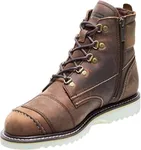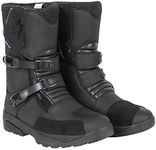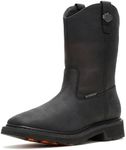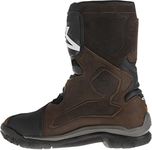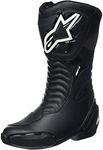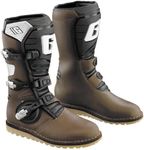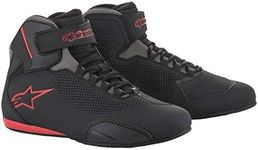Buying Guide for the Best Motorcycle Boots
Choosing the right motorcycle boots is essential for both safety and comfort while riding. Motorcycle boots are designed to protect your feet, ankles, and lower legs from impacts, abrasions, and the elements. The right pair can also improve your control over the bike and make long rides much more enjoyable. When shopping for motorcycle boots, it's important to consider how and where you'll be riding, as different boots are suited for different types of riding, such as touring, racing, commuting, or off-road adventures. Understanding the key features will help you find boots that match your needs and riding style.MaterialThe material of motorcycle boots affects their durability, protection, and comfort. Most boots are made from leather, synthetic materials, or a combination of both. Leather is known for its toughness and abrasion resistance, making it a popular choice for protection, while synthetic materials can offer lighter weight and better water resistance. Some boots also include reinforced areas with materials like Kevlar or hard plastic for extra protection. If you ride in wet conditions, look for boots with waterproof membranes. For hot climates, consider boots with breathable panels. Your riding environment and personal comfort preferences should guide your choice of material.
Protection FeaturesProtection features in motorcycle boots include reinforced toe boxes, ankle support, shin plates, and heel cups. These elements are designed to shield your feet and lower legs from impacts and abrasions in case of a fall or accident. Some boots also have armor inserts or sliders for added safety. If you ride at high speeds or on challenging terrain, prioritize boots with more comprehensive protection. For casual or city riding, lighter protection may be sufficient, but always ensure the boots cover and support your ankles.
Closure SystemThe closure system refers to how the boots are fastened, such as zippers, Velcro, buckles, or laces. Each system offers different levels of convenience, security, and adjustability. Zippers and Velcro are quick and easy to use, while buckles provide a secure fit, especially for off-road or racing boots. Laces can offer a more customized fit but may be less secure in a crash unless covered by a protective flap. Choose a closure system that balances ease of use with the level of security you need for your riding style.
Sole TypeThe sole of a motorcycle boot affects grip, comfort, and durability. Some soles are designed for maximum traction, which is important for off-road or adventure riding, while others are smoother for better movement on sport bikes. Stiffer soles provide more protection and support, especially for long rides or standing on pegs, but may be less comfortable for walking. If you plan to walk a lot in your boots, look for a more flexible sole. Consider your typical riding conditions and whether you need more grip or comfort.
HeightBoot height determines how much of your lower leg is protected. Tall boots, which reach up to the calf or higher, offer the most protection and are ideal for racing, touring, or off-road riding. Mid-height boots provide a balance between protection and comfort, suitable for commuting or casual rides. Short boots or riding shoes are lighter and more comfortable for walking but offer less protection. Your choice should depend on the level of protection you want and how much time you spend riding versus walking.
Waterproofing and VentilationWaterproofing keeps your feet dry in wet conditions, while ventilation helps keep them cool in hot weather. Some boots have waterproof membranes like Gore-Tex, while others use breathable materials or mesh panels for airflow. If you often ride in the rain, prioritize waterproof boots. For hot climates or summer riding, look for boots with good ventilation. If you ride in varying conditions, consider boots that offer a balance of both features.
Fit and ComfortFit and comfort are crucial for long rides and overall safety. Boots that are too tight can cause discomfort and restrict movement, while loose boots may not provide adequate protection. Look for boots with adjustable features, such as straps or buckles, and try them on with your usual riding socks. Walk around in them to ensure there are no pressure points. Your riding position and the type of bike you use can also affect how the boots feel, so consider these factors when choosing the right fit.




